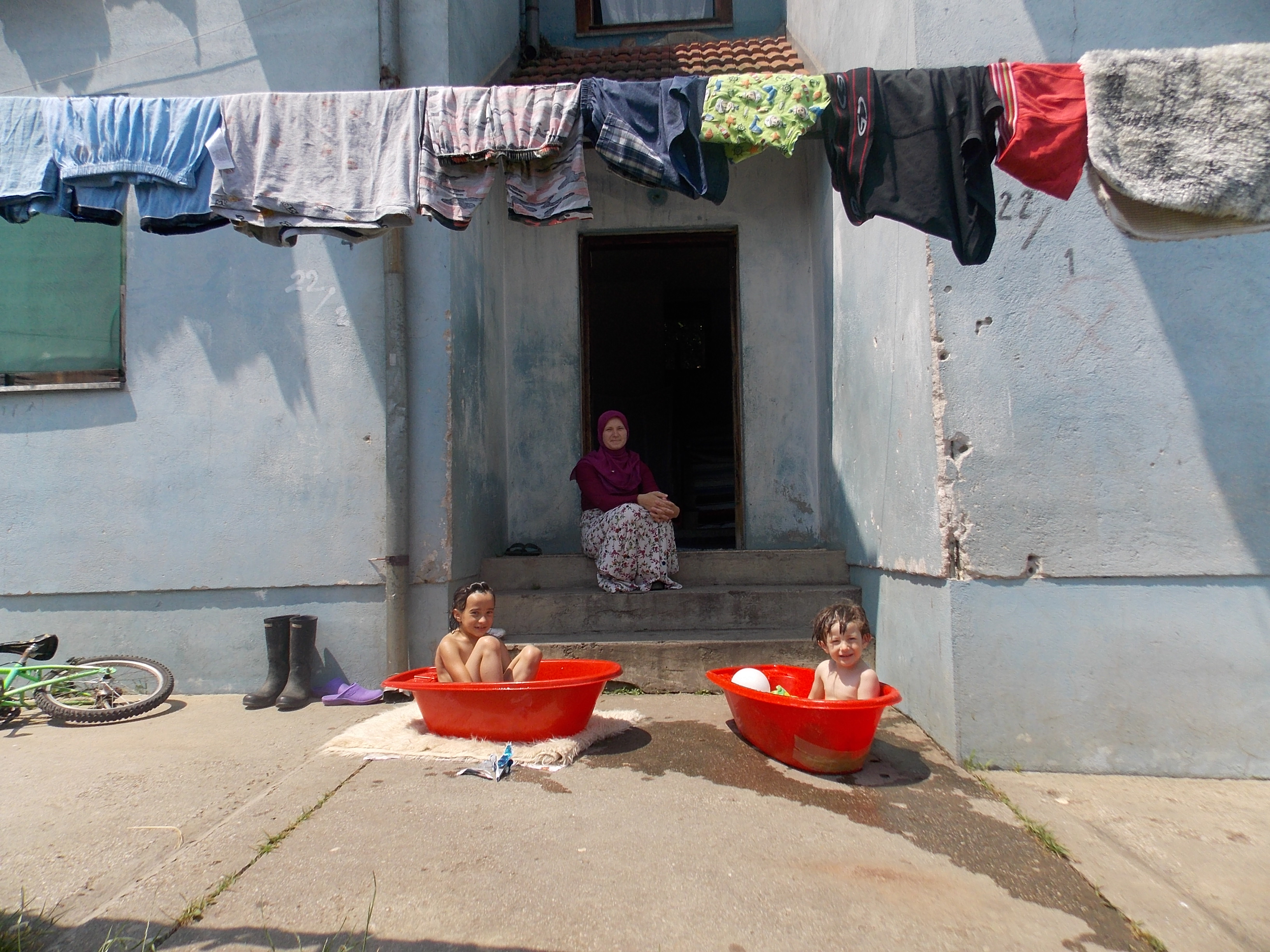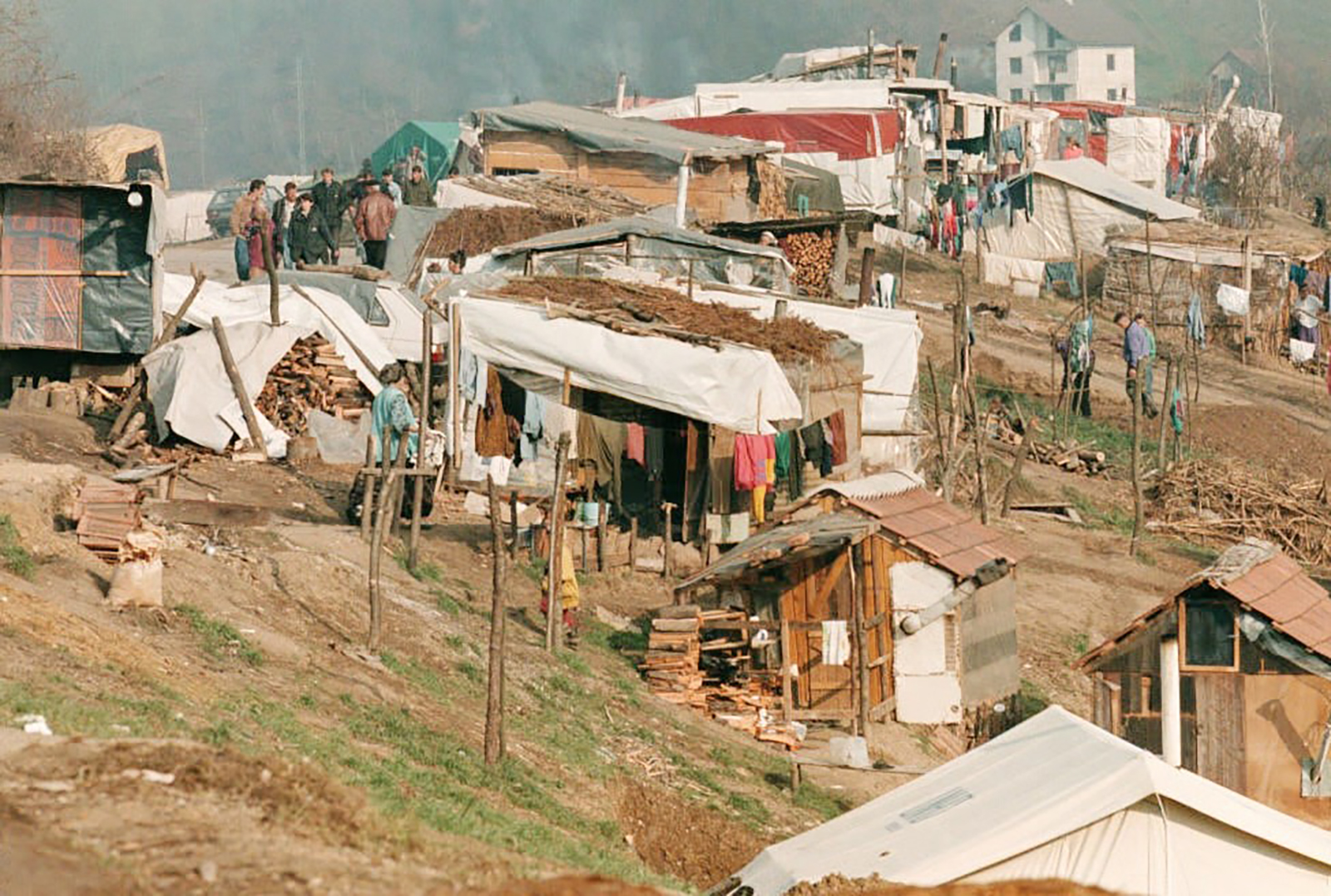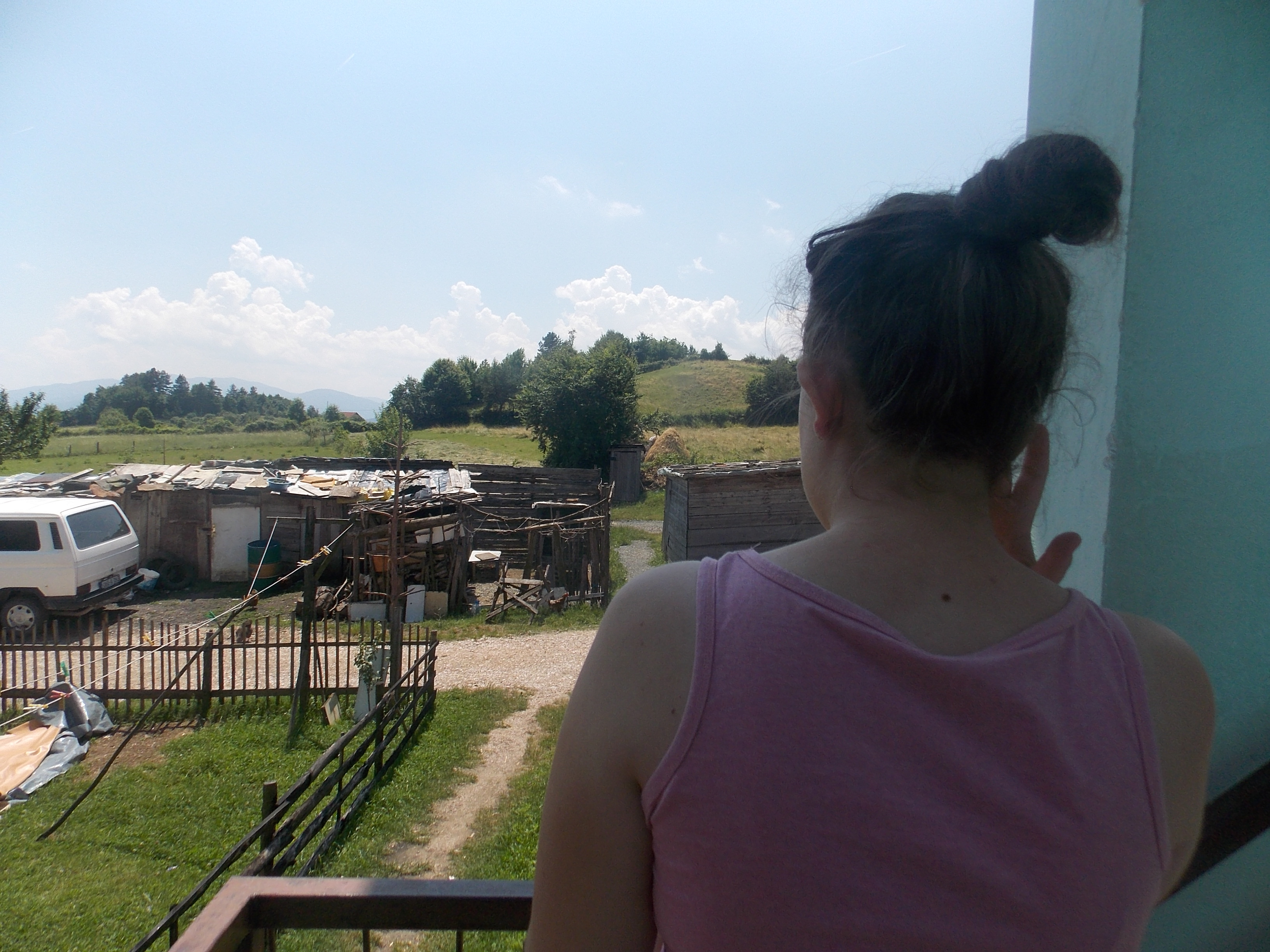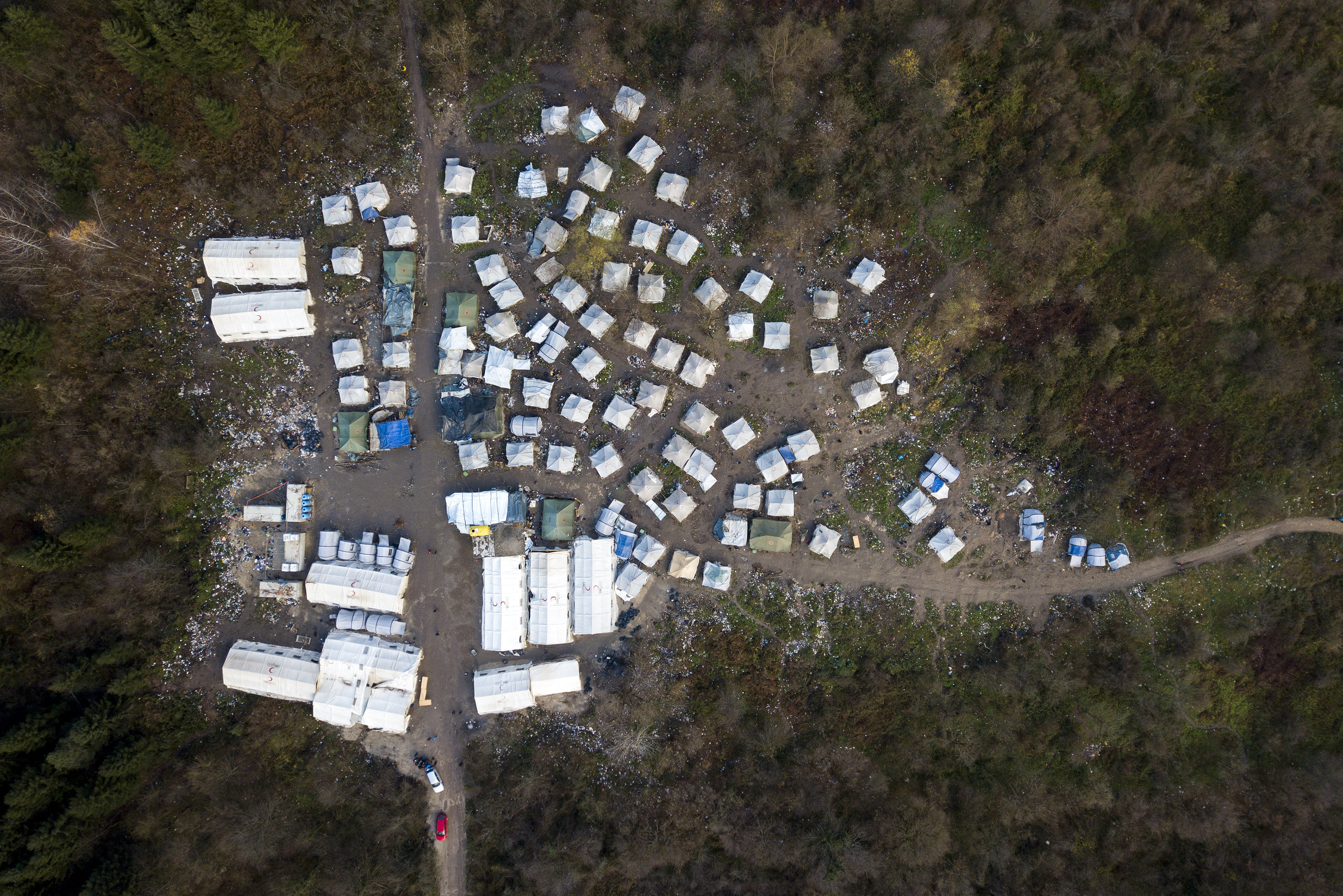How Bosnia’s neglect of its wartime displaced foreshadowed its latest humanitarian crisis.
On Easter Sunday 2010, Angelina Jolie came to the eastern Bosnian town of Rogatica and performed a miracle. The Hollywood star had been touring the country in her off-screen role as ambassador for the UN refugee agency, UNHCR. At a makeshift shelter in a former school building, she was introduced to Lena Babic, an elderly woman who had lost her home in the Bosnian war 18 years previously. The women communicated through an interpreter – Angelina speaking of her children, Lena of her long wait for a new home.
“I didn’t realise she was a famous actress,” Lena said, recalling the meeting. “It felt as though I had known her for ages.” They shared coffee and cakes and, as it was Easter Sunday, cracked open some boiled, handpainted eggs – an Orthodox tradition celebrating the miracle of Christ’s resurrection.
Soon, Lena’s encounter with Angelina would provide further cause for celebration. Media coverage of their meeting highlighted the dire conditions at the shelter and prompted offers of foreign aid. Within two years, Lena and her neighbours had been re-housed in a new, purpose-built apartment block – an achievement that, in post-war Bosnia, counts as nothing short of miraculous.
Some 8,000 people who lost their homes in the Bosnian war are still waiting for miracles. They have spent 25 years in wretched conditions in so-called “collective centres” – wartime shelters that were meant to be temporary but that have, for want of alternatives, become permanent. Six years ago, European governments pledged a 60-million euro loan towards re-housing them, but barely any new homes have been built.
Last year, the political system responsible for this prolonged failure was ensnared in a humanitarian crisis – this time over housing migrants and refugees stranded in the Bosnian winter on their way to western Europe. The crisis was not strictly Bosnia’s fault. The European Union’s border policies, as enforced by neighbouring Croatia, were largely to blame.
Bosnia’s treatment of thousands of foreign citizens, seeking to make a home elsewhere, is foreshadowed by its treatment of thousands of its own citizens, waiting for a home for 25 years.
However, Bosnia’s response made a bad situation worse. As with the collective centres, the provision of shelter and foreign aid was held up by a complex political system that breeds neglect and muddles questions of accountability. At the height of the crisis this winter, thousands of refugees and migrants were crammed into a disease-ridden camp in Vučjak, north-western Bosnia, while local leaders argued over relocating them.
Bosnia’s political system is modelled on the US-mediated Dayton Agreement, credited with ending the conflict. But the system’s failings, exposed by the stalemate over Vučjak, cannot be blamed on the agreement alone.

A new generation is growing up in collective centres such as this one in Mihatovići. Photo: © Milena Mitrović
“The purpose of Dayton was to stop the war, not to set up a functioning state,” said Jessie Barton-Hronešová, a research fellow and Balkans expert at Oxford University’s Department for International Development. “Bosnia could have been a functioning state if the political will had been there, if the key politicians had decided to make it a functioning state.”
From the island camps of Greece to the wall along the Hungarian border, the way individual countries have responded to the migrants and refugees has said as much about them as it has about the European Union. In Bosnia, Europe’s migration crisis has intersected with state failure. The country’s treatment of thousands of foreign citizens, seeking to make a home elsewhere, is foreshadowed by its treatment of thousands of its own citizens, waiting for a home for 25 years.
‘We lost precious time.’
The latest effort to re-house residents of the collective centres was launched in 2013, via the Council of Europe Development Bank (CEB), a Paris-based body originally established to house refugees after World War Two. The bank’s project for Bosnia, nicknamed CEB II, envisaged spending 104 million euros on new social housing that would replace 121 of the 158 collective centres still in use. More than half those funds, or 60 million euros, were raised by CEB member states – mostly European Union countries – and offered via the bank as an interest-free loan. The remainder was meant to be raised by local authorities in Bosnia.
However, the project is running at least five years behind schedule. The original completion date of 2017 has been revised to 2022. So far, only eight of the 121 collective centres have been closed. The CEB’s country manager for Bosnia, Karin Lepp, told the Balkan Investigative Reporting Network, BIRN, that the bank was not responsible for implementing the project. “It is up to the Bosnian authorities to use their borrowed funds,” she said. “We don’t have any type of mechanism to place pressure on the state.”
Whatever comes of the project, it will be too late for Grozdan Cvijanović. The former soldier died last February, aged 59. He had spent the final months of his life alone, bedridden and incontinent, in a wooden cabin on the outskirts of Zvornik, a town in eastern Bosnia. The cabin is part of a barracks-like complex that was built to house the workers of a nearby alumina plant. Dating to the Yugoslav era, it has served as a collective centre since the war.
Grozdan’s neighbours told BIRN that his mental and physical health, already poor, deteriorated swiftly after the death of his mother. As he became confined to bed, his living quarters were overrun by rats, drawn to his leftover meals. Towards the end of his life, Grozdan was relying on his neighbours to fend off the pests. Milan Petrović, who lives in a nearby cabin, described seeing a rat jump off Grozdan’s bed and run into another room. “On its way back, the rat tried to pass me by,” he told BIRN. “I said, ‘oh no, not today you don’t’, and killed it on the spot.”
Why are people living and dying in a rat-infested wartime shelter, 25 years after the war ended? The search for answers passes through the complicated political system built upon the Dayton Agreement. The system has honoured the agreement’s most pressing objective: granting the players in an inconclusive three-way conflict a stake in the peace. It has done so by dividing Bosnia into two entities of roughly equal size – the Republika Srpska, where Serbs are the majority, and the Federation of Bosnia-Herzegovina, made up mainly of Bosniaks and Croats. These entities form an intermediate level of administration between the central government and local government. To complicate matters further, the Federation has two levels of local government – cantons and municipalities – while the Republika Srpska has only one level – the municipalities.
The state’s tasks have been neglected and its resources squandered without anyone knowing whom exactly to blame. Boris Divjak, founder of the Bosnian chapter of Transparency International: “And so everyone ends up accusing each other of failures or lack of transparency.”
Many duties of the state, such as the provision of housing and education, have been assigned across all these levels, as a way of reconciling demands for extensive autonomy with power-sharing. In practice, however, this has led to duplication and dysfunction. The state’s tasks have been neglected and its resources squandered without anyone knowing whom exactly to blame.
“Things fall between the cracks, between the different layers of government,” Boris Divjak, founder of the Bosnian chapter of the anti-corruption watchdog, Transparency International, told BIRN. “And so everyone ends up accusing each other of failures or lack of transparency.”
The CEB’s Karin Lepp said local authorities across Bosnia bore the greatest responsibility for closing down the collective centres. The next greatest responsibility was at the entity level, while the central government had “limited authority” in implementing CEB II.
In Zvornik, the town’s mayor, Zoran Stevanović, acknowledged that the municipality was ultimately responsible for closing down the collective centre beside the alumina plant. He said the local authorities had not initially treated the centre as a priority, as they had been overwhelmed by demand for housing from displaced people after the war. It was only in 2011 that they applied to buy new apartments for the centre’s residents – but, Stevanovic said, officials at the entity level in Republika Srpska took four years to review and reject the application. “We wanted to solve the matter as soon as possible but we lost precious time,” he told BIRN.

The war in Bosnia forced more than half the country’s population from their homes. Photo: © Anja Niedringhaus / EPA / picturedesk.com
The Republika Srpska administration did not comment on the specific case of the collective centre by the alumina plant. However, Dragan Strbac, the entity’s most senior official responsible for housing the displaced, said there was “no problem at all” with implementing CEB II in Zvornik. He also insisted that the project was proceeding without a hitch across the entity. “Everything is unfolding according to the original schedule,” he told BIRN.
The central government official responsible for implementing CEB II, Bosnia’s Minister for Human Rights and Refugees, Semiha Borovac, did not respond to BIRN’s requests for an interview. Instead, the ministry e-mailed a statement saying that the project had been delayed by its “complexity” and by “municipalities changing their requests” for assistance.
‘Subsidy for corruption’
The Bosnian war forced some 2.2 million people – or more than half the country’s population – from their homes. When the conflict ended in 1995, the UNHCR estimated that collective centres nationwide were sheltering some 50,000 people. The 8,000 who remain there today, scattered across 158 sites, are the ones that had nowhere better to go. They are mostly the poor, the elderly and the infirm, and in some cases, the young raised by them. They have no friends in politics and, unlike the veterans of the conflict, they do not constitute a lobby. Their country has failed them.
“Every single issue in Bosnia right now is politicised, and this too is a question of political priorities,” said Dr Barton-Hronešová, from Oxford University’s Department for International Development. “These 8,000 people are, however, not going to swing any elections. So let’s be honest – no one cares about them.”
Bosnia has failed on many fronts. It does not function as a unitary state because its political system has preserved wartime divisions. Following elections in 2018, the country spent more than a year in administrative paralysis as its leaders argued over the future government. Meanwhile, its ablest citizens have been fleeing abroad, escaping a youth unemployment rate that is one of the highest in the world. The economy, weighed down by corruption, is kept afloat by aid, remittances, and loans.
At a collective centre in Mihatovići village in the Federation of Bosnia-Herzegovina, young families worry about raising a new generation amidst squalor and widespread drug addiction. With a population of roughly 500, the centre is the largest in Bosnia. Its residents include many from the impoverished Roma community, housed in decrepit bungalows with peeling facades covered in grass and mould.
“These 8,000 people [who remain to be sheltered] are, however, not going to swing any elections. So let’s be honest – no one cares about them.”
“It was tough growing up here,” said Adnan Mekic, a 25-year-old resident of the centre, citing the drug problem. He credits his father, an elderly man in crutches, with keeping him and his sisters “out of trouble”. Now a young father himself, Adnan routinely travels to Germany to work as a welder.
Bosnia is obliged to re-house the collective center residents as part of its commitment to the Dayton Agreement, which enshrines the right of the displaced to return to their homes. Yet its failure to honour this obligation cannot be attributed solely to the political system modelled upon that agreement. It is also the fault of generations of Bosnian politicians.
Senad Bratić, a former president of the Republika Srpska government committee responsible for refugees’ rights, said CEB II had not been implemented because the political will was lacking. “The means are there, the contracts have been signed, the tenders have been announced,” he told BIRN. “But people also need to have the desire to do the work.”
Corruption has also played a part in the failure to replace the collective centers, although not in the obvious sense: there is no evidence that the foreign funds allocated for the project have been misspent. However, Transparency International’s Boris Divjak said Bosnia’s need for foreign funding was itself a symptom of the endemic misspending elsewhere in the system.

Many collective center residents have given up hope of being re-housed. Photo: © Milena Mitrović
“The money that comes from international bodies serves as a subsidy for corruption,” Divjak said. “If there was no corruption in Bosnia, if it was a transparent state, the money from tax revenues and remittances would be sufficient to keep the machine ticking.” This was true of every sector, he said, including housing. “There has been enough money to close the collective centers by now, locally and nationally,” he said.
As Angelina Jolie demonstrated, replacing the collective centers need not be a particularly expensive task. Lena’s new home in Rogatica was built within two years after the US government pledged 500,000 US dollars (453,000 euros) towards it. When a fleeting visit by a Hollywood star accomplished what the Bosnian authorities could not deliver in decades, it served as testament not so much to the power of celebrity as to the torpor of the postwar state.
Of the 50,000 refugees and migrants estimated to have entered Bosnia last year, some 8,000 have been stranded there as a result of pushbacks. Many ended up sleeping rough in the mountains near the border, or in the overcrowded, unsanitary camp at Vučjak, near the north-western town of Bihać.
The camp was built last summer by the Bihać authorities on the site of a former rubbish dump surrounded by minefields, with no access to running water or electricity. As the autumn brought rain and freezing temperatures, aid agencies warned that the site had become too dangerous for their staff and for the refugees and migrants who depended upon them. At one point in October, Vučjak was host to some 2,500 people – more than three times its capacity. It was also in the grip of a scabies epidemic.
A range of international humanitarian and human rights agencies – from the Red Cross to Amnesty International – urged local authorities to seal off the site and relocate its residents, while the European Union pledged funds towards an alternative camp. However, all attempts to find alternative housing were opposed by local communities, unwilling to accommodate refugees and migrants. And so the camp stayed open for months, as the winter conditions worsened and the warnings continued.

Vučjak is located in a forest and a former landfill site that presents significant health risks and is surrounded by mines left over from the war. Photo: © PIXSELL / EXPA / picturedesk.com
In an interview with BIRN last November, the mayor of Bihać, Suhret Fazlic, criticised politicians in the area who had blocked attempts to relocate the camp. He also criticised Bosnian state authorities for delegating the task of dealing with the migrants and refugees to municipalities such as his own, near the border with Croatia. The state, he told BIRN, ought to register the migrants, house them and process their applications. But instead, he said, it just “sent them on to Bihać”.
Vučjak was eventually shut down in early December, when a facility in the capital, Sarajevo, agreed to take in its inhabitants.
‘Not optimistic’
The people in the collective centres are not in desperate need, unlike the refugees and migrants. Their dwellings, however unsuitable, are warmer than the tents at Vučjak. They mostly have access to running water and electricity, and they are no longer on the move. But the story of Vučjak illustrates what the residents of the collective centres have long known – you need more than funds to secure shelter in Bosnia; you must also have the political system on your side.
“They keep us here like cattle,” said Jasmin Rizmanović, the resident of a collective centre in the Sarajevo suburb of Hrasnica, in the Federation of Bosnia-Herzegovina. “Tons of foreign aid was sent to help us but we have seen no benefit whatsoever.”
Jasmin’s family fled the Serb-dominated east of Bosnia when he was 12 years old. He is now in his thirties, and bringing up children of his own in a crumbling, mouldy building housing some 50 people. His sister-in-law, Amina Rizmanović, says she often finds cockroaches crawling over the family as they sleep.
“They keep us here like cattle. Tons of foreign aid was sent to help us but we have seen no benefit whatsoever.”
Borislav Bojić, a former chairman of Bosnia’s state commission on human rights, said time was running out to address the issue. “Most of the people in the collective centres are elderly, they won’t live for 150 years,” he told BIRN. “This problem ought to be resolved right away but I’m not optimistic.”
Lena Babic and her neighbours in Rogatica consider themselves lucky. They used to share a toilet in the collective centre in the old school building. In their new home, dubbed Villa Angelina after its benefactor, the apartments came with toilets, fridges and washing machines.
“We would’ve rotted long ago, were it not for Angelina,” said Persa Radović, Lena’s next-door neighbour, who is also in her eighties. The two women meet every morning for coffee – the second of their shared daily rituals. The day begins with their first ritual: thumping the wall between their apartments, and listening out for a thump in response. “When I hear that,” Persa said, “I think that’s good, Lena’s still alive!”
First published on 22 January 2020 on Balkaninsight.com.
This text is protected by copyright: © Milena Mitrović / BIRN, edited by Timothy Large. If you are interested in republication, please contact the editorial team.
Copyright information on pictures, graphics and videos are noted directly at the illustrations. Cover picture: A complex of wooden barracks on the outskirts of Zvornik is one of more than 100 collective centres across Bosnia that have yet to be replaced. Photo: © Milena Mitrović
This article was produced as part of the Balkan Fellowship for Journalistic Excellence, supported by the ERSTE Foundation in cooperation with the Balkan Investigative Reporting Network.